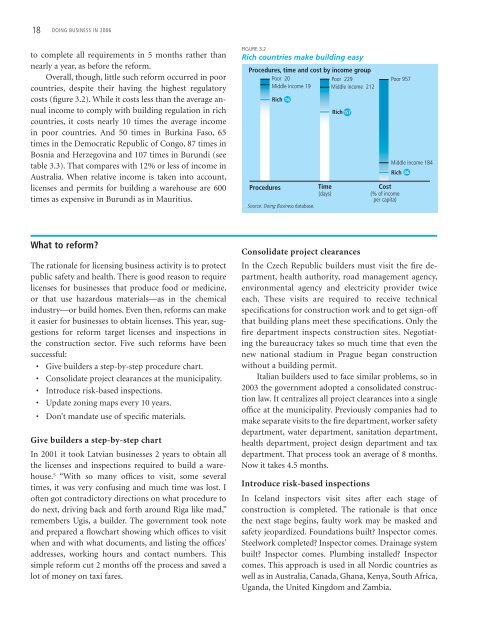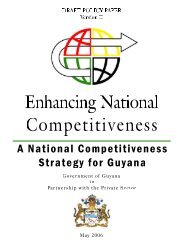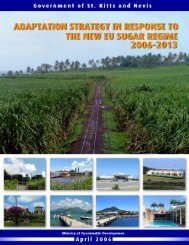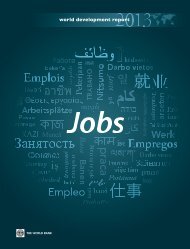Creating
Doing Business in 2006 -- Creating Jobs - Caribbean Elections
Doing Business in 2006 -- Creating Jobs - Caribbean Elections
Create successful ePaper yourself
Turn your PDF publications into a flip-book with our unique Google optimized e-Paper software.
18 DOING BUSINESS IN 2006<br />
to complete all requirements in 5 months rather than<br />
nearly a year, as before the reform.<br />
Overall, though, little such reform occurred in poor<br />
countries, despite their having the highest regulatory<br />
costs (figure 3.2). While it costs less than the average annual<br />
income to comply with building regulation in rich<br />
countries, it costs nearly 10 times the average income<br />
in poor countries. And 50 times in Burkina Faso, 65<br />
times in the Democratic Republic of Congo, 87 times in<br />
Bosnia and Herzegovina and 107 times in Burundi (see<br />
table 3.3). That compares with 12% or less of income in<br />
Australia. When relative income is taken into account,<br />
licenses and permits for building a warehouse are 600<br />
times as expensive in Burundi as in Mauritius.<br />
<br />
<br />
<br />
<br />
<br />
<br />
<br />
<br />
<br />
<br />
<br />
<br />
<br />
<br />
<br />
<br />
<br />
<br />
What to reform?<br />
The rationale for licensing business activity is to protect<br />
public safety and health. There is good reason to require<br />
licenses for businesses that produce food or medicine,<br />
or that use hazardous materials—as in the chemical<br />
industry—or build homes. Even then, reforms can make<br />
it easier for businesses to obtain licenses. This year, suggestions<br />
for reform target licenses and inspections in<br />
the construction sector. Five such reforms have been<br />
successful:<br />
• Give builders a step-by-step procedure chart.<br />
• Consolidate project clearances at the municipality.<br />
• Introduce risk-based inspections.<br />
• Update zoning maps every 10 years.<br />
• Don’t mandate use of specific materials.<br />
Give builders a step-by-step chart<br />
In 2001 it took Latvian businesses 2 years to obtain all<br />
the licenses and inspections required to build a warehouse.<br />
5 “With so many offices to visit, some several<br />
times, it was very confusing and much time was lost. I<br />
often got contradictory directions on what procedure to<br />
do next, driving back and forth around Riga like mad,”<br />
remembers Ugis, a builder. The government took note<br />
and prepared a flowchart showing which offices to visit<br />
when and with what documents, and listing the offices’<br />
addresses, working hours and contact numbers. This<br />
simple reform cut 2 months off the process and saved a<br />
lot of money on taxi fares.<br />
Consolidate project clearances<br />
In the Czech Republic builders must visit the fire department,<br />
health authority, road management agency,<br />
environmental agency and electricity provider twice<br />
each. These visits are required to receive technical<br />
specifications for construction work and to get sign-off<br />
that building plans meet these specifications. Only the<br />
fire department inspects construction sites. Negotiating<br />
the bureaucracy takes so much time that even the<br />
new national stadium in Prague began construction<br />
without a building permit.<br />
Italian builders used to face similar problems, so in<br />
2003 the government adopted a consolidated construction<br />
law. It centralizes all project clearances into a single<br />
office at the municipality. Previously companies had to<br />
make separate visits to the fire department, worker safety<br />
department, water department, sanitation department,<br />
health department, project design department and tax<br />
department. That process took an average of 8 months.<br />
Now it takes 4.5 months.<br />
Introduce risk-based inspections<br />
In Iceland inspectors visit sites after each stage of<br />
construction is completed. The rationale is that once<br />
the next stage begins, faulty work may be masked and<br />
safety jeopardized. Foundations built? Inspector comes.<br />
Steelwork completed? Inspector comes. Drainage system<br />
built? Inspector comes. Plumbing installed? Inspector<br />
comes. This approach is used in all Nordic countries as<br />
well as in Australia, Canada, Ghana, Kenya, South Africa,<br />
Uganda, the United Kingdom and Zambia.

















